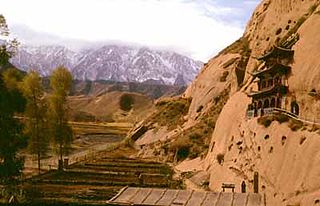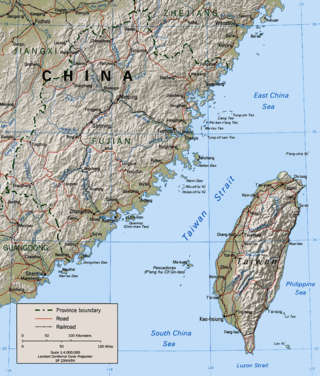Related Research Articles

Hu Shih (Chinese: 胡適; pinyin: Hú Shì; Wade–Giles: Hu2 Shih4; 17 December 1891 – 24 February 1962), also known as Hu Suh in early references, was a Chinese diplomat, essayist and fiction writer, literary scholar, philosopher, and politician. Hu contributed to Chinese liberalism and language reform and advocated for the use of written vernacular Chinese. He participated in the May Fourth Movement and China's New Culture Movement. He was a president of Peking University. He had a wide range of interests such as literature, philosophy, history, textual criticism, and pedagogy. He was also a redology scholar.

Gansu is a province in Northwest China. Its capital and largest city is Lanzhou, in the southeast part of the province.

Lanzhou is the capital and largest city of Gansu Province in Northwest China. Located on the banks of the Yellow River, it is a key regional transportation hub, connecting areas further west by rail to the eastern half of the country. Historically, it has been a major link on the Northern Silk Road and it stands to become a major hub on the New Eurasian Land Bridge. The city is also a center for heavy industry and petrochemical industry.

The Subei Mongol Autonomous County is an autonomous county within the prefecture-level city of Jiuquan in the northwest of Gansu Province, China, bordering Xinjiang to the west, Qinghai Province to the southeast and Mongolia's Govi-Altai Province to the north. Containing the northernmost point in Gansu, Subei is split into two non-contiguous sections and has an area of 66,748 km2 (25,772 sq mi) and had approximately 13,046 inhabitants in 2000. To the east it shares a border with Ejin Banner, Alxa League, Inner Mongolia.
Wang Sanyun is a former Chinese politician. He began his political career in Guizhou province, before serving in Sichuan, Fujian, and Anhui provinces. He served as Anhui governor between 2007 and 2011, and was transferred to Gansu to serve as Communist Party Secretary between 2011 and 2017. Shortly after leaving office, he was put under investigation for violating party discipline by the Central Commission for Discipline Inspection.

The 1920 Haiyuan earthquake occurred on December 16 in Haiyuan County, Ningxia Province, Republic of China at 19:05:53. It was also called the 1920 Gansu earthquake because Ningxia was a part of Gansu Province when the earthquake occurred. It caused destruction in the Lijunbu-Haiyuan-Ganyanchi area and was assigned the maximum intensity on the Mercalli intensity scale. About 258,707~273,407 died, making it one of the most fatal earthquakes in China, in turn making it one of the worst disasters in China by death toll.

Huan County or Huanxian is an administrative district in eastern Gansu province, China at the junction of three provinces: Gansu, Shaanxi to the northeast, and Ningxia to the west and northwest. It is under the administration of the prefecture-level city of Qingyang.
Hu Dongmei is a Chinese sprint canoer who competed in the mid-1990s. At the 1996 Summer Olympics in Atlanta, she was eliminated in the semifinals of the K-2 500 m event.
Lu Wucheng is a former Chinese official who spent most of his career in Gansu province. He was the vice Chairman of the Standing Committee of the Gansu Provincial People's Congress and Communist Party Secretary of Lanzhou. Lu also was the member of 12th National People's Congress. On January 23, 2015, Lu Wucheng was placed under investigation by the Communist Party's anti-corruption agency. He was the first high-ranking politician being examined from Gansu province after the 18th Party Congress in 2012.

The Kaohsiung Japanese School is a Japanese international school on the campus of Kaohsiung Municipal Lingya District Jhong-Jheng Elementary School in Lingya District, Kaohsiung, Taiwan in the Republic of China.
Liping (黎坪镇) is a town in Wen County, Gansu, China. In 2008 it had a population of 13,024. The township's administrative centre is in Lijiaba village (李家坝), and it governs over 22 administrative villages. In 2016 it was upgraded from township to town.
The Lanzhou–Hezuo railway or Lanhe railway is a railway line under construction that will connect Lanzhou to Linxia and Hezuo by rail. It is proposed to continue the line from Hezuo to Chengdu. The railway line will be the first railway to be constructed in Linxia and Gannan.
Gongxingdun Airport also called Lanzhou Donggang Airport (兰州东岗机场) was an airport in Gongxingdun township, Chengguan District, Lanzhou, Gansu, China. It was the primary airport of Lanzhou from the 1930s to 1970.
Tang Chongti is a Chinese parasitologist and professor of Xiamen University. In 1991, she was elected as an academician of the Chinese Academy of Sciences. She is mainly engaged in research on pathogenic developmental biology, epidemiology, and prevention of zoonotic parasitic diseases.

The Fujian–Taiwan relations, also known as the Min–Tai relations, refers to the relationship between Fujian, which is located in mainland China, and Taiwan, which is across the Taiwan Strait. Since the average width of the Taiwan Strait is 180 kilometers, Fujian and Taiwan are adjacent, similar in both climate and environment. Although the relationship between Taiwan and Fujian has changed with the development of history, the two places have maintained close relations in terms of personnel, economy, military, culture and other aspects. At present, Taiwan residents are mostly descendants of immigrants from mainland China, of which the southern Fujian ethnic group is the main group, accounting for 73.5% of Taiwan's total population. In terms of culture, language, religion, and customs, Fujian and Taiwan also share similarities.

China National Highway 341 will run from Jiaonan in Shandong to Haiyan in Qinghai. It is one of the new trunk highways proposed in the China National Highway Network Planning.

Honglou Times Square is a 313 metres (1,026.9 ft) tall skyscraper in Lanzhou, Gansu, China. Construction started in 2012 and was completed in 2018. It is the tallest building in Gansu.
Huajialing Town is a township-level administrative unit under the jurisdiction of Tongwei County, Dingxi City, Gansu Province, People's Republic of China. It is located roughly equidistant from the seats of Tongwei, Huining and Anding.
The East-west cultural debate is a debate on the similarities and differences, the strengths and weaknesses, and the trade-offs between Eastern culture and Western culture during the mainland period of the Republic of China. This debate began with the founding of the New Youth magazine in 1915 and ended before the Northern Expedition in 1927. During this period, hundreds of people participated in the debate with over a thousand articles, focusing on Chinese culture and Chinese society.
References
- ↑ Zhang Dainian and Cheng Yishan, "Chinese Culture and Cultural Debates," Beijing: Renmin University of China Press, 1990, p. 352.
- ↑ Hu Shi: "Full Internationalization and Total Westernization", in "Hu Shi and Chinese and Western Culture" (Buffalo Press), pp. 139-140
- ↑ "談談台灣早年的中西文化論戰". 苦勞網. 2018-03-20. Archived from the original on 2019-08-22. Retrieved 2019-08-08.
- ↑ 兰州军区政治部宣传部;责任编辑:王杰 (1987). "《坚定不移". 甘肃理论学刊. 甘肃省兰州市: 中共甘肃省委党校(甘肃行政学院): 12–15. ISSN 1003-4307. Archived from the original on 2019-09-30.
- ↑ 刘洋波 (2008). 全盘西化思潮的兴衰(1979-2007) (Thesis thesis). 北京大学.
- ↑ 浮現中的女同性戀: 現代中國的女同性愛欲. 臺灣大學出版中心. 2014. pp. 109–133. ISBN 9789863500384. Archived from the original on 2016-03-04. Retrieved 2015-10-13.